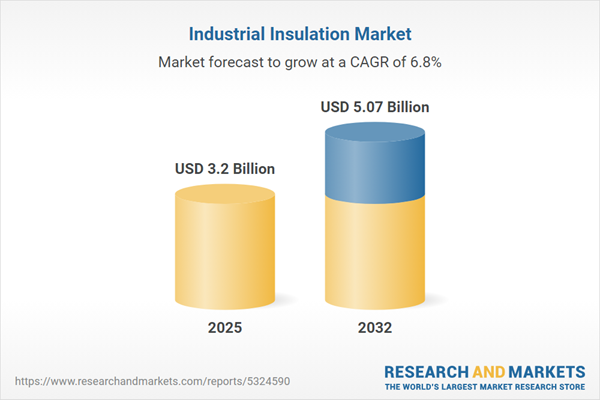Speak directly to the analyst to clarify any post sales queries you may have.
The industrial insulation market is undergoing notable transformation as organizations seek solutions that extend equipment longevity, support sustainable agendas, and uphold operational reliability. Executive teams face increasing pressure to recalibrate insulation strategies, aligning with evolving regulations and seizing prospects within both core and adjacent industries.
Market Snapshot: Industrial Insulation Market Growth and Outlook
The industrial insulation market is demonstrating robust growth, with projections indicating expansion from USD 2.99 billion in 2024 to USD 3.20 billion by 2025 and reaching USD 5.07 billion by 2032. The market’s momentum is propelled by rising investment in energy-efficient technologies, regulatory changes introducing advanced technical standards, and a consistent drive for cost efficiencies. Industrial insulation plays a foundational role in sectors such as power generation, automotive, and chemical processing, delivering process reliability and operational excellence. Increasingly, organizations are adopting compliant insulation solutions to secure market entry, optimize performance, and remain adaptive to shifting policy requirements across global regions.
Scope & Segmentation: Comprehensive Industrial Insulation Market Analysis
This report addresses the decision-making needs of executives focused on asset management, procurement, and investment strategies within industries where insulation drives performance and safety. The analysis covers diverse dimensions integral to informed planning:
- Material Types: Aerogel, cellular glass, elastomeric choices like EPDM and NBR, mineral wool, polyurethane, expanded polystyrene, and extruded polystyrene address compliance requirements, sustainability objectives, and varied operational needs.
- Product Types: Boards, blocks, fibrous materials, foams, cold and wet-applied mud, single- and multi-layer pipe insulation, panels, pipes, rolls, and sheets cater to both new projects and retrofit markets.
- End User Segments: Automotive OEM and aftermarket, chemical and petrochemical, HVAC and refrigeration, oil and gas, food and beverage, and energy industries, each with distinct regulatory drivers influencing insulation preferences.
- Application Areas: Acoustic insulation supports workplace safety, fire protection mitigates risk, and thermal management enhances system efficiency and lifespan.
- Construction Types: Brownfield upgrades and greenfield initiatives require tailored insulation approaches to address specific lifecycle management and compliance mandates.
- Installation Types: On-site customization, prefabricated options, and modular solutions offer flexibility for scaling and adapting to complex project parameters.
- Regions Covered: Strategic insights are provided for the Americas, Europe, Asia-Pacific, and Middle East & Africa, taking into account regulatory frameworks and infrastructure development unique to each geography.
- Company Coverage: Profiles include Owens Corning, Johns Manville International, Knauf Insulation, Rockwool International, Saint-Gobain Isover, Armacell, Kingspan, NMC NV, URSA Insulation, and Dow, with a focus on technical leadership and ability to offer customized solutions.
Key Takeaways: Strategic Insights for Senior Decision-Makers
- Advanced insulation materials, such as aerogel composites and bio-based polymers, are elevating system durability and aligning solutions with corporate sustainability targets.
- The integration of digital technologies, such as IoT-enabled monitoring and predictive maintenance tools, is streamlining operations and reducing exposure to unexpected asset downtime.
- Organizations in mature markets emphasize compliance with stringent technical benchmarks, while businesses in emerging markets focus on flexibility and scalability to address surging infrastructure development.
- Mergers, acquisitions, and ongoing technical advancements enable businesses to meet shifting regulatory landscapes and customize offerings for evolving client requirements.
- Investments in research and development are sparking the evolution of specialized insulation solutions, ensuring both compliance and robust operational continuity for a diverse user base.
Tariff Impact: Adapting to Evolving Supply Chains and Cost Structures
Recent changes to US tariffs are prompting manufacturers and suppliers in the industrial insulation market to alter sourcing strategies and modify cost structures. Shifts toward increased domestic production, diversification of supplier bases, and updated contractual agreements are strengthening supply chain resilience. These adjustments position organizations to maintain continuity and navigate macroeconomic uncertainty.
Methodology & Data Sources
Research for this report combines direct interviews with industry executives, detailed examination of technical standards and regulatory guidelines, and expert validation. Forward-looking forecasts are developed using scenario analysis, providing senior leaders with actionable insights for navigating complex decision environments.
Why This Report Matters
- Enables better procurement and technology investment decisions by outlining market drivers and sustainability imperatives related to industrial insulation systems.
- Prepares organizations to respond rapidly to regulatory changes and supply chain shifts, strengthening competitive agility and supporting effective risk mitigation strategies.
- Delivers strategic direction for deploying advanced insulation technologies and capitalizing on cross-regional growth opportunities.
Conclusion
Senior leadership can use this report to refine insulation investment strategies, bolster operational performance, and stay ahead of regulatory and technological shifts that shape global industrial markets.
Additional Product Information:
- Purchase of this report includes 1 year online access with quarterly updates.
- This report can be updated on request. Please contact our Customer Experience team using the Ask a Question widget on our website.
Table of Contents
3. Executive Summary
4. Market Overview
7. Cumulative Impact of Artificial Intelligence 2025
Companies Mentioned
The companies profiled in this Industrial Insulation market report include:- Owens Corning
- Johns Manville International, Inc.
- Knauf Insulation GmbH
- Rockwool International A/S
- Saint-Gobain Isover
- Armacell International S.A.
- Kingspan Group plc
- NMC NV
- URSA Insulation, S.A.
- Dow Inc.
Table Information
| Report Attribute | Details |
|---|---|
| No. of Pages | 180 |
| Published | October 2025 |
| Forecast Period | 2025 - 2032 |
| Estimated Market Value ( USD | $ 3.2 Billion |
| Forecasted Market Value ( USD | $ 5.07 Billion |
| Compound Annual Growth Rate | 6.7% |
| Regions Covered | Global |
| No. of Companies Mentioned | 11 |









